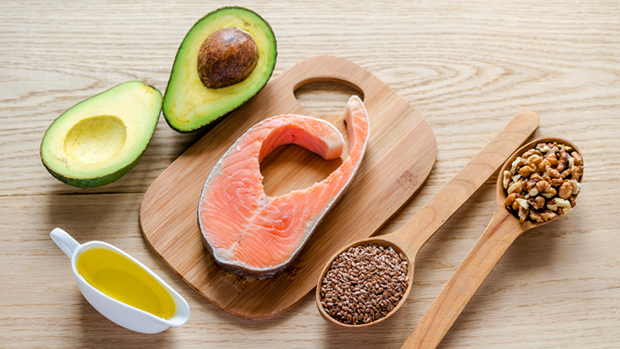Our acceptance of dietary fat has come a long way. Just a few short years ago, athletes, bodybuilders, and health nuts alike set aside their differences in agreement that every low-down dirty member of the oily "9 calories per gram" gang should be rounded up and hanged at sunset from the tallest tree.
Thankfully, times have changed. Health authorities today accept that monounsaturated fats can reduce the risk of cardiovascular disease, and the essential fatty acids alpha-linolenic acid (omega 3) and linoleic acid (omega 6) are required just for life itself. Even the once-vilified saturated fat is now being re-classified as "not so bad after all," considering it's necessary for proper cell membrane function.
It's not just about boring ol' health and wellness, either. According to warrior nerd Dr. Lonnie Lowery, a low fat diet can lead to a 10-15% drop in serum Testosterone and an increase in SHBG (Sex Hormone Binding Globulin), a protein that binds to Testosterone, rendering it ineffective. So not only is less T being made, whatever's left is being increasingly bound up, gagged, and whisked away to an unmarked government office for "reeducation."
So an extra tablespoon or two of oil is a good little T booster, especially if you're not into fatty cuts of meat or seafood, or swell up like a puffer fish at the very sight of eggs or nuts.
The trouble is, certain fats are better to cook with, while some are better used as a topping. Others have extra nutrients that make them nutritional powerhouses, to borrow an overused phrase.
Let's examine what oils you should be using and why. I'll give each a "squat rack rating" with 4 squat racks being best. First, I'll describe the considerations I took in ranking the oils.
Ranking Considerations
Usefulness for Cooking
- The more saturated a fat is, the less likely it is to go rancid when used in cooking.
Rancidity means that the fat is breaking down chemically due to oxidation and ingesting these fats is the reason we see increased rates of heart disease and atherosclerosis. To avoid eating rancid fats, you should cook with oils higher in saturated fat.
The chart at the bottom shows the percentage of saturated, monounsaturated, and polyunsaturated fats in various oils, which should help make choosing a good cooking oil easier. For example, coconut oil would be a good choice for cooking as it's 91% saturated fat, whereas safflower oil shouldn't be used as it's 75% polyunsaturated.
- Do not let oils reach their smoke point during cooking.
The smoke point is where the oil reaches a temperature at which it starts to break down rapidly. The oil may turn darker in color, get thicker, or even start to stink. Obviously a higher smoke point is best for cooking purposes, but rather than break out the trusty thermometer, just use a more stable oil to cook with.
Usefulness as a Topping
When I say a topping, I mean to add to a shake, drizzle on top of a salad or meal, or just drink like a fatty acid shooter. You can even use that gold-rimmed shot glass you stole from TGI Fridays.
Since you shouldn't cook with highly polyunsaturated oils due to their fragile state and propensity for oxidation, this is the perfect way to get your EFA's – especially if you're not a fan of fatty fish like wild Alaskan salmon. This is also a great way to add monounsaturated fats.
Ratio Rationale
- Evaluate the omega 6 to omega 3 ratio.
Cutting-edge nutrition authorities now advise a 3:1 ratio of omega 6 to omega 3 fats, a radically different approach from the 20:1 ratio found in the typical Western diet. To reach this ideal ratio, oils too heavy in omega 6 should be avoided as they promote an inflammatory environment.
By the way, in case you believe that arterial plaques are mostly saturated fat, here's some fatty facts for you: Over 50% of arterial plaque is polyunsaturated, while only 20% is saturated fat.
Any Additional Powerhouse Nutrients?
This is where you have to look beyond the poly, mono, and saturated percentages. Some oils contain high levels of natural antioxidants, while others contain virtually none. Some strengthen the immune system and promote healthy skin, while others are pro-inflammatory and can lead to degenerative disease.
Note: I'm referring to unrefined oils only! Don't use refined oils as they're put through commercial processes like bleaching and deodorization that strip nutrients and reduce omega 3 concentrations. The chart below only references unrefined oils – refined oils aren't even up for consideration!
Top 6 Oils
So without further ado, here are my top 6 oils and their "squat rack ranking."
1. Red Palm Oil
Rating: ![]()
![]()
![]()
![]()
Most pundits say to avoid this oil; I couldn't disagree more. The oil has a very unique, reddish-orange color due to it being loaded with carotenoids including alpha carotene, which is even more cancer protective than beta carotene. To put this in perspective, palm oil has 300 times more carotenoids than tomatoes! Interestingly, even though Vitamin A levels can get too high (which is rare), this isn't true for their precursors, the carotenes.
It doesn't stop there. The Vitamin E in red palm oil contains all the tocopherols and tocotrienols. Evidence continues to mount that the tocotrienols are very powerful antioxidants, possibly even stopping LDL oxidation. You can even cook with this oil as it's very heat stable. I like to add a tablespoon or two onto my eggs in the morning.
2. Coconut Oil
Rating: ![]()
![]()
![]()
![]()
Another very misunderstood oil. Early studies concluded that it raised triglyceride levels but failed to mention that the studies used hydrogenated or refined versions.
Unrefined coconut oil is almost all saturated fat, and a great deal of the fat is medium chain triglycerides, which are sent to the liver and converted into quick energy. Interestingly, farmers in the 1940s used coconut oil as a feed, thinking all the saturated fat would help their cows put on weight quickly. It didn't work. The cows were all active and lean, and went on to win "most ripped" at the heavyweight class at that year's Mr. Olympia. Not surprisingly, the idea was deemed a failure.
What I like most about coconut oil is its lauric acid content. This fat, typically only found in breast milk, is a powerful immune system strengthener and is part of the reason breastfeeding is so healthy for infants. There's a huge body of evidence showing lauric acid to be a great anti-viral, anti-fungal, and anti-bacterial substance as well.
3. Macadamia Nut Oil
Rating: ![]()
![]()
![]()
![]()
This oil is a powerhouse. It has even more monounsaturated fat than olive oil (85%), with a large portion being oleic acid. This is important because that particular fatty acid helps to incorporate omega 3 fatty acids into cell membranes. Experts Mary Enig and Fred Pascatore have documented how these fats lessen the need for EFA's. Lastly, it's also a very stable oil to cook with and can withstand temperatures as high as 410 degrees.
4. Extra Virgin Olive Oil
Rating: ![]()
![]()
![]()
America's darling, and with good reason. There's a mountain of evidence showing that EVOO raises "good" cholesterol or HDL due to its high amounts of oleic acid. This is my preferred oil for salads, but don't be afraid to just drink it or put it in your shakes. You can cook with it on low heat, although it's not as heat stable as the more saturated fats out there, or even as stable as other monounsaturated fats like macadamia nut oil.
5. Hemp Seed Oil
Rating: ![]()
![]()
This oil actually has the ideal balance of omega 6 to 3 (57% omega 6 and 19% omega 3) and even has GLA in it. Don't cook with it, but feel free to toss it in shakes or on salads.
6. Walnut Oil
Rating: ![]()
This oil is a great salad topper. 59% of it is omega 6, 16% is omega 3, so it's not far off from the ideal ratio, either. Unfortunately, it has a really low smoke point, so stick to using it with salads.
Honorable mention
Avocado Oil
This oil has an extremely high smoke point of 520 degrees and is loaded with monounsaturated fatty acids (70%). However, the taste is a little odd, even for those diagnosed with avocado fetishes.
The Crappy Eight
These oils weren't allowed to participate due to their horrendous omega 6 to 3 ratio. Do NOT consume these oils.
| Oil | Omega 6 to 3 ratio | Oil | Omega 6 to 3 ratio |
| Safflower oil | 78 to 1 | Peanut oil | 34 to 1 |
| Sunflower oil | 69 to 1 | Pistachio oil | 31 to 1 |
| Corn oil | 59 to 1 | Pumpkin seed oil | 20 to 1 |
| Sesame oil | 45 to 1 | Soybean oil | 11 to 1 |
The Franken-trio
These popular oils were chased out of town by angry villagers armed with pitchforks and torches for having a "Frankstein-ish" genetic manipulation to them.
- High oleic safflower
- High oleic sunflower
- Canola oil
The Raw Stats
| Oil | Monounsaturated % | Polyunsaturated % | Saturated % | Smoke Point |
| Avocado oil | 70 | 10 | 20 | 520 |
| Almond oil | 78 | 17 | 5 | 420 |
| Canola Oil | 54 | 37 | 7 | 400 |
| Coconut oil | 7 | 2 | 91 | 350 |
| EVOO | 76 | 8 | 16 | 375 |
| Flax seed oil | 19 | 72 | 9 | 225 |
| Grape seed oil | 17 | 71 | 12 | 400 |
| Macadamia nut oil | 85 | 6 | 9 | 410 |
| Peanut oil | 47 | 29 | 18 | 320 |
| Hemp seed oil | 12 | 80 | 8 | 330 |
| Red Palm oil | 40 | 10 | 50 | 450 |
| Rice bran oil | 48 | 35 | 17 | 490 |
| Safflower oil | 13 | 75 | 12 | 225 |
| Sesame oil | 42 | 45 | 17 | 350 |
| Sunflower oil | 23 | 65 | 12 | 225 |
| Walnut oil | 25 | 56 | 18 | 320 |
Note: Smoke points can vary based on origin.
Conclusion
We all have our favorite foods, but as you go about your clean-eating ways, don't be afraid to swap in a few other healthy choices from this list. Much the same as with the foods in your diet, a little fatty acid variety will provide you with a broader spectrum of nutrients, so don't get stuck on using just one oil.
I hope you enjoyed this, and maybe even learned a thing or two!



